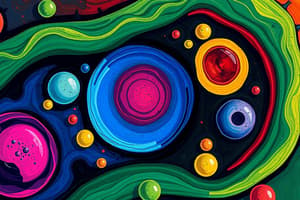Podcast
Questions and Answers
What is the primary function of the nucleus in a cell?
What is the primary function of the nucleus in a cell?
- To act as the brain of the cell (correct)
- To package proteins and nutrients
- To provide structural support
- To produce energy for the cell
Which of the following best describes the role of mitochondria in a cell?
Which of the following best describes the role of mitochondria in a cell?
- They package proteins for delivery
- They provide energy to the cell (correct)
- They aid in organelle movement
- They store nutrients and waste products
What distinguishes prokaryotic cells from eukaryotic cells?
What distinguishes prokaryotic cells from eukaryotic cells?
- Prokaryotes perform photosynthesis, while eukaryotes do not.
- Prokaryotes have a cell wall, while eukaryotes do not.
- Prokaryotes lack a nucleus and membrane-bound organelles. (correct)
- Prokaryotes are larger and more complex than eukaryotes.
What is the primary function of the Golgi apparatus in a cell?
What is the primary function of the Golgi apparatus in a cell?
Which structure in plant cells is responsible for photosynthesis?
Which structure in plant cells is responsible for photosynthesis?
What is the role of the endoplasmic reticulum in a cell?
What is the role of the endoplasmic reticulum in a cell?
Which organelle is primarily responsible for producing proteins?
Which organelle is primarily responsible for producing proteins?
What function does the vacuole serve in a cell?
What function does the vacuole serve in a cell?
Which characteristic is true for prokaryotic organisms?
Which characteristic is true for prokaryotic organisms?
In which organelle does photosynthesis occur?
In which organelle does photosynthesis occur?
Flashcards are hidden until you start studying
Study Notes
Cell Structure and Function
- Cell membranes function as selective barriers, allowing water and oxygen to enter while expelling waste.
- Cytoplasm provides organizational structure and facilitates the movement of organelles within the cell.
- Ribosomes are responsible for synthesizing proteins, essential for various cellular functions.
- The nucleus, often referred to as the cell's control center, houses genetic material and regulates cellular activities.
Organelles and Their Roles
- Endoplasmic Reticulum (ER) includes Rough ER, which has ribosomes for protein synthesis, and Smooth ER, which is involved in lipid synthesis and detoxification.
- The Golgi apparatus operates as the processing and packaging center, preparing proteins and nutrients for distribution to other parts of the cell.
- Mitochondria, known as the powerhouses of the cell, convert nutrients into energy (ATP) through cellular respiration.
- In plant cells, the cell wall provides structural support and protection, maintaining cell shape.
Specialized Organelles
- Chloroplasts are unique to plant cells, capturing sunlight to drive photosynthesis, which converts light energy into chemical energy.
- Vacuoles serve as storage compartments within cells, holding substances such as nutrients, waste products, or water.
Types of Organisms
- Organisms are classified into two primary categories: prokaryotes and eukaryotes.
- Prokaryotes, such as bacteria, lack a nucleus and do not possess membrane-bound organelles, making them simpler in structure.
- Eukaryotes include animals, plants, and fungi, characterized by the presence of a nucleus and complex organelles.
Cell Structure and Function
- Cell membranes function as selective barriers, allowing water and oxygen to enter while expelling waste.
- Cytoplasm provides organizational structure and facilitates the movement of organelles within the cell.
- Ribosomes are responsible for synthesizing proteins, essential for various cellular functions.
- The nucleus, often referred to as the cell's control center, houses genetic material and regulates cellular activities.
Organelles and Their Roles
- Endoplasmic Reticulum (ER) includes Rough ER, which has ribosomes for protein synthesis, and Smooth ER, which is involved in lipid synthesis and detoxification.
- The Golgi apparatus operates as the processing and packaging center, preparing proteins and nutrients for distribution to other parts of the cell.
- Mitochondria, known as the powerhouses of the cell, convert nutrients into energy (ATP) through cellular respiration.
- In plant cells, the cell wall provides structural support and protection, maintaining cell shape.
Specialized Organelles
- Chloroplasts are unique to plant cells, capturing sunlight to drive photosynthesis, which converts light energy into chemical energy.
- Vacuoles serve as storage compartments within cells, holding substances such as nutrients, waste products, or water.
Types of Organisms
- Organisms are classified into two primary categories: prokaryotes and eukaryotes.
- Prokaryotes, such as bacteria, lack a nucleus and do not possess membrane-bound organelles, making them simpler in structure.
- Eukaryotes include animals, plants, and fungi, characterized by the presence of a nucleus and complex organelles.
Studying That Suits You
Use AI to generate personalized quizzes and flashcards to suit your learning preferences.




